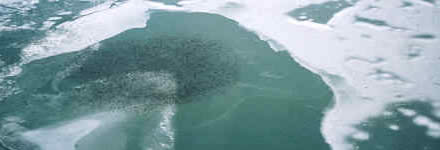Featured Projects
Waterfowl population survey: Lake St. Clair
 |
Like
the eye of a storm, these black specks framed by encroaching
ice on Lake St. Clair represent thousands of wintering
waterfowl. Photo: CWS. Click
to enlarge. |
On a brisk December morning at London International Airport,
a four-seater Cessna climbs into a pale sky etched with wisps
of cloud and snow. The small plane heads west. Below, the
cityscape gives way to a checkerboard of residential subdivisions,
farms, harvested fields and forest fragments.
 |
Waterfowl
take advantage of waste grain on farm fields. Photo:
CWS. Click
to enlarge. |
On board, Canadian Wildlife Service (CWS) staff review the
morning’s flight route with the pilot. Gary McCullough
and Norm North are preparing for an aerial survey of waterfowl
along the wetlands and open iceholes of Lake St. Clair. The
survey will document use by waterfowl populations of significant
habitat areas of the lower Great Lakes. Some migrating birds
linger along the shoreline well into winter, as long as ice
conditions are suitable, feeding on waste grain in the fields
that fan out from the shoreline.
The CWS first surveyed the Lake St. Clair area by air in
1968. This survey is part of the CWS contribution to the Eastern
Habitat Joint Venture (EHJV), one of 16 such “joint
ventures” established across the continent under the
North American Waterfowl Management
Plan. With a shared overall goal to conserve wetland and
upland habitats for migratory birds, partners of the EHJV
in Ontario are the federal government, the provincial government,
Ducks Unlimited Canada, the Nature Conservancy of Canada and
Wildlife Habitat Canada.
At the mouth of the Thames River, the pilot banks to permit
a better view of the frozen wetlands and begins to wing his
way back and forth above flocks of birds. Norm watches for
bird groupings and directs the route, while Gary notes species
and numbers into a hand-held recorder. The survey continues
over now-drained Bradley Marsh and moves on to the federally-protected
St. Clair National Wildlife Area.
To the untrained eye, it is difficult to identify the birds.
Most are distinctive only by comparison: white versus dark
silhouettes against the ice, large and smaller shapes moving
in the air. Gulls are easier to discern than ducks, as are
the vivid, white Mute Swans, a large species that is abundant
but not native to the area.
 |
A
Green-winged Teal, one of the waterfowl species wintering
at Lake St. Clair. Photo: CWS. Click
to enlarge. |
Norm and Gary continue to survey the nearshore iceholes on
the lake. Assemblies of Mallard and Black Ducks shift in complex
patterns against the dark patches of water. With satisfaction,
Gary notes a small grouping of Green-winged Teals, whose presence
is atypical for this time of year.
Returning to the shoreline, the small plane meanders like
a dragonfly over inland marshes, covering Big Point, Mitchell’s
Bay, partially drained Ford Marsh, and Bear Creek, before
making a broad loop over Walpole Island and Seaway Island,
and finishing up along the international boundary. With the
job completed, the pilot turns back to London, rising up and
over a fast-moving squall sprinkling the landscape –
and the birds – with a skiff of snow.
| How
many birds? |
| Mallard
Ducks |
19,703 |
| Black
Ducks |
7,250 |
| Mute
Swans |
539 |
| Canada
Geese |
337 |
| Canvasbacks |
300 |
| Green-winged
Teal |
25 |
| Tundra
Swans |
9 |
| Red-breasted
Mergansers |
2 |
(Survey
date: December 16, 2002) |
Gary and Norm will later determine that they observed 28,000
birds. A prior survey in late November had a total of 75,000
birds, including 18 different species. The autumn peak usually
occurs near the end of October or early November. In autumn,
totals can peak at about 150,000; spring numbers may total
about 60,000.
For population surveys of this nature, the reality is that
numbers of birds cannot be determined with complete accuracy.
Small groups on the ground or water, or flushed by the aircraft,
are counted directly. For larger gatherings, depending on
the size of the group, surveyors estimate blocks of hundreds
or thousands. In the case of large, mixed flocks, different
species are estimated by percentage of the total flock.
More than just numbers, however, the key to long-term monitoring
is in consistent application of methodology to achieve a reliable
outcome. Over time, the resulting data reveal notable trends;
the rise and fall of wild populations, the distribution of
populations through a given range, and the response of the
waterfowl to changing habitat conditions. These data are vital
to setting EHJV conservation program objectives and to monitoring
the subsequent impacts of conservation and management actions
on wild populations.
Learn more
|